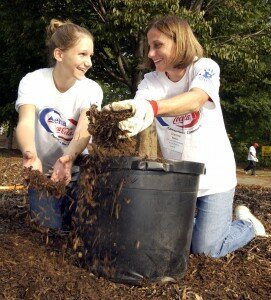What Will You Bring to the Table?
 Today’s guest post comes from Sally Hallingstad and is republished from the Points of Light blog. Sally is Director of Events & Marketing at Metro Volunteers, a HandsOn Volunteer Action Center in Denver. Through generationOn’s What Will You Bring to the Table? initiative, Sally and her team are engaging youth in taking action against child hunger. Today, Sally offers four ways adults can support youth in tackling hunger through hands-on volunteer projects.
Today’s guest post comes from Sally Hallingstad and is republished from the Points of Light blog. Sally is Director of Events & Marketing at Metro Volunteers, a HandsOn Volunteer Action Center in Denver. Through generationOn’s What Will You Bring to the Table? initiative, Sally and her team are engaging youth in taking action against child hunger. Today, Sally offers four ways adults can support youth in tackling hunger through hands-on volunteer projects.
- Create Partnerships.
Often-times, in a youth/adult relationship there is an unspoken rule that the adults make all the decisions of where to go, what to do, etc. Many times, this is needed in order to be productive and efficient; however, in order for a youth to find his/her passion for community, adults need to learn to let go of the dictatorship and allow them the option to explore different ideas and ways to make our world a better place. Brainstorming is a great opportunity to let the youth have their voice while allowing the adult to show support while implementing a certain amount of guidance. - Create Awareness.
Child hunger is a prominent, global topic that is relayed with television ads and billboard campaigns raising funds for children in developing countries. What many youth don’t realize is how close to home hunger really is. Take the time to research facts about child hunger in your community; this ultimately will make it a more “real” issue to them if they understand that child hunger is local and could easily be affecting someone they know. - Create Action.
There are a number of hunger-focused organizations across our nation that do an amazing job of engaging volunteers in their mission. Because of them, volunteerism can come in many forms, whether it’s giving time to a food pantry, serving a meal at a soup kitchen or participating in a national campaign like What Will You Bring to the Table? By encouraging youth to give their time to a cause, adults are helping them understand that no matter how old they are or how much time/money they have they are able to fight hunger in their own way. - Create Voices.
The most powerful tool an individual has is their voice. Encourage youth to talk about their experiences to their families and classmates. The more people that become aware of the needs in their community, the greater chance we have of engaging people in the fight against child hunger.
Through April 30, you can engage youth in tackling child hunger through generationOn’s What Will You Bring to the Table? Through hands-on projects, food drives and advocacy, 1 million meals will be generated for children who are hungry. Click here for GenerationOn’s age-appropriate resources to educate youth about hunger and guide them in taking action through easy-to-implement projects.














